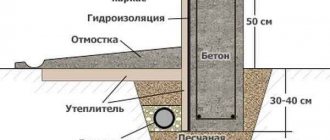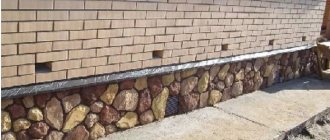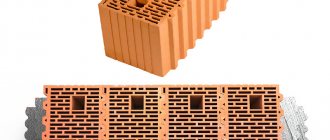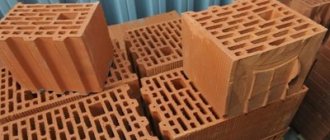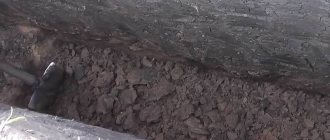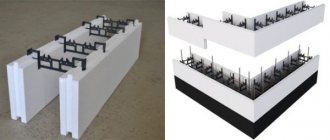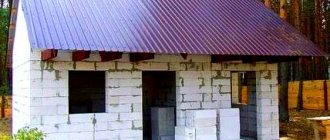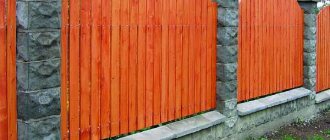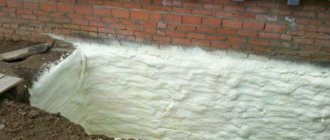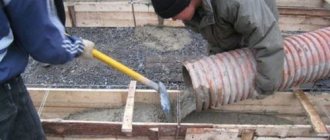Everyone, without exception, wants to have a reliable foundation. And one of the most reliable and predictable is the tape one. But a monolithic strip foundation takes a long time to build: it takes three days to assemble the formwork alone, and you still have to knit reinforcement, then concrete it and wait several days until it gains at least half its strength. This will take at least two to three weeks. It’s good if you have such a reserve of time, but what if you don’t? There is a way out: smart people came up with the idea of transferring part of the work to the enterprise - they make concrete blocks - FBS. From these, a foundation is then assembled, which is called a prefabricated strip foundation. It’s easy to make a FBS foundation with your own hands.
When using this technology, the foundation is assembled from reinforced concrete blocks of different types and sizes. That is why it is often called block or prefabricated. These are all the same type.
Advantages, disadvantages and features of the device
A shallow foundation is a not too deep foundation for a building. The average depth is about 0.2-0.5 m. The need to use this type of house foundation is due to the fact that construction is planned on heaving soils. The advantage of a shallow foundation is obvious, since with a buried foundation, the tangential heaving forces acting along the side surface of the reinforced concrete structure of the foundation for construction significantly exceed the load created by light houses. And in the case when a shallow foundation is used on heaving soils, this problem is eliminated.
In addition to everything, this version of the foundation for construction allows you to do the construction yourself. Firstly, when laying this type of foundation, it is enough to use half the amount of materials that would be needed if a buried foundation were being built. Secondly, a shallow foundation with your own hands does not require much effort to prepare a very deep trench, since sometimes you can get by with a depth of 20 cm.
However, there is also a drawback to this type of foundation for construction. So, the degree of soil heaving plays a role. In case of increased heaving, it is necessary to use reinforcing mesh, and weak heaving soils allow you to make do with a concrete base. There is also another variety - a shallow columnar foundation. Its use is quite limited due to the small loads it can withstand, which is explained by the small supporting area. And this parameter, in turn, characterizes the bearing capacity of the foundation for construction. But a shallow columnar foundation with your own hands is also much easier to create and much more economical.
If you do not have qualifications or basic skills in construction, you can choose an alternative option. Considering that for any foundation for construction it is necessary to prepare a concrete mixture, make formwork, and, if necessary, strengthen it with reinforcement, a lot of time and effort is required. But there is a simplified option - a shallow foundation made of FBS blocks (foundation building blocks).
What is this material? These are ready-made blocks, which will cost approximately the same amount as completing the foundation for construction completely independently. However, their strength is high enough to withstand even multi-story buildings. Therefore, a shallow foundation for a brick house can be made from such material.
How to calculate the amount of material
To find out the required amount of building material that is supposed to be used, it is necessary to calculate the depth of the foundation for the building. The main parameter that is taken into account is the depth of soil freezing. The calculation of a shallow foundation is also influenced by the degree of soil heaving, as well as the height of the groundwater.
For example, if the freezing level of slightly heaving soil is 1 m, a foundation depth for construction of 0.5 m will be sufficient. In addition to these parameters, the load level should also be taken into account. Thus, a shallow foundation for a frame house, due to its lightness, can be made with a shallower depth at the same level of soil freezing. Next you need to calculate the total volume of the concrete mixture. Why is the value of the perimeter of the future house and the length of all internal walls summed up? The volume of the trenches is then calculated.
To calculate the mass of the concrete mixture, you need to multiply the resulting figure by 2,500 kg/cubic meter. m. It is quite possible to calculate the amount of cement if you divide the volume of the concrete mixture into five parts, which are cement, sand and water.
Step-by-step instructions for performing construction work
The construction of shallow foundations is a combination of basic materials: a concrete slab and a sand cushion. If the first of them takes on the load transmitted by the building, then sand is an excellent way to maximally smooth out the uneven distribution of base deformations. A shallow foundation for a wooden house also needs a sand cushion, despite the lightweight type of construction. The thickness of the sand layer under the base is determined by the level of load transmitted by the object.
After the site has been marked, trenches can be dug. It is important to first perform the necessary calculations to determine the sufficient depth of the foundation for construction. At one stage of construction, a blind area for a shallow foundation is constructed. If in any other case this is done in order to avoid the negative impact of wastewater on the concrete foundation of the house, that is, the blind area plays the role of waterproofing, then with a shallow foundation it additionally helps to negate the effect of soil heaving in frosty times.
Returning to the step-by-step execution of the work, it should be noted that after sand has been laid at the bottom of the trench as a cushion, you need to take care of waterproofing. For this purpose, bitumen-polymer roll materials are used. Then the formwork is built, if necessary, the reinforcement frame is fixed and concrete is poured. At the next stage, the shallow foundation is insulated with polystyrene foam. This is done on the outside of the foundation for the building in order to protect the basement floor, if there is one, or the residential building itself from cooling.
Insulation of a shallow foundation can be carried out not only on the outside of the concrete foundation of the house. In areas of more severe climates, a different insulation scheme is used, in which the heat-insulating material is laid horizontally directly under the base of the foundation. This is done before pouring the concrete mixture. There is another insulation scheme, which is a combined version of the two methods described. That is, the thermal insulation is located both in the vertical and horizontal planes, maximally protecting the foundation from the effects of low temperatures.
Waterproofing
For high-quality waterproofing of a building, it is necessary to have a proper drainage system around the foundation.
Waterproofing the foundation itself is needed for two purposes: preventing moisture from penetrating into the structure of the house from the foundation (done on the horizontal surface of the foundation) and preventing moisture from penetrating into the foundation from the soil and the environment, so that the concrete does not collapse when this moisture freezes. Let's talk about the second one.
It is done in many ways:
- coating - bitumen, polymer and epoxy mastics are used for this;
During coating waterproofing, molten bitumen is applied with a brush to concrete foundation elements - spraying liquid plastic mass (polyurethane) is the most expensive, but also very effective method;
Spraying polyurethane is the most expensive, but also very effective method. - plastering - special plaster mixtures with plasticizing additives are used for this;
Plastering the foundation is the most labor-intensive method - pasting - films (with polymer glue) and membranes and glass insulation (they are self-adhesive).
The foundation is covered with waterproofing in an overlapping manner
Pasting, as a rule, is combined with coating with mastic before and after pasting. If the pasting is multilayer, a mesh is laid between its layers, which is used for conventional plastering.
The placement of layers when pasting should only be vertical; the vertical overlap should not be less than 10 centimeters, the horizontal overlap should not be less than 30, and pasting should be done from below.
Foundation for a house made of FBS blocks
A house made of FBS blocks is a very popular type of construction. This material is used to create load-bearing elements of buildings that can be used at temperatures from -70 to +50 degrees. Their most relevant use is for the construction of basement and basement surfaces and laying strip foundations. It is worth noting that such blocks are perfectly combined with all types of soil and climatic conditions. In our article we will find out how to build a building from FBS correctly and independently.
Pros and cons of the material
Before choosing blocks for installation work, you need to familiarize yourself with the advantages and disadvantages of the FBS material. Namely these:
- Good strength;
- Durability;
- Resistance to mechanical and biological influences;
- High level of thermal insulation;
- Environmental Safety;
- Wide range of block models.
Such advantages expand the range of applications of FBS products, allowing them to be used in the most uncomfortable conditions. Construction specialists strongly recommend using such material for laying basements, as this will reduce the time it takes to build a house. Of course, such blocks have a huge number of advantages, but we must also consider the disadvantages of these products:
- It is worth noting that the blocks have a high cost, but it is lower than that of a monolith;
- In addition, in most cases it is not possible to obtain maximum sealing at the joints. If you install a self-leveling foundation and a plinth, you can get a more reliable structure. This design is especially relevant in difficult climatic conditions.
- For construction work on the construction of the plinth, it is necessary to use the services of special machines.
Attention! FBS products are more expensive than other materials, and require additional waterproofing treatment of the base or basement.
Selecting blocks for installation
When choosing a building material for a house, namely FBS blocks, first of all, you need to check the product documentation and the availability of a passport. The official product certification must contain the following information:
- Contact information of the manufacturer;
- Serial code and lot number;
- Dimensions, brand, weight;
- Indicator of strength during compression;
- Resistance to frost and moisture;
- Basic operating rules.
We make the foundation from blocks with our own hands
The construction process using FBS products is no different, but the work must be performed in strict accordance with the instructions. So, the first thing you need is to calculate all the values. Let's talk about this in more detail.
Calculation of the quantity of materials
Before you go shopping. We need to know how much material we need to complete the construction. The volume of load-bearing masonry is calculated using the following formula:
V= l by a by h, that is, length multiplied by thickness and height. Next, the resulting value is divided into indicators of one block. If the building has the shape of a parallelepiped, then the calculation is complete, the resulting amount will be the amount of material needed.
Attention! Here it is very important not to forget that FBS elements have a lot of weight, so you should use the services of specialized equipment to carry out the work. Based on this fact, professionals recommend performing calculations for middle blocks, since they will be easier to install.
Today, manufacturers produce several standard parameters for block products. Such values simplify construction work. Usually the block has a height of 58 cm, but for calculations you need to use the number 60. The side walls may be slightly convex, but this is not a mandatory norm, so most blocks are even. Design features are based on the financial capabilities of the owner.
Attention! Of the main requirements, we must not forget that construction should begin by creating a sand and gravel cushion for the foundation. All work is done easily, the main thing is to do everything accurately and correctly.
Tools and materials for performing work
As we have already found out, installation of the foundation for the house is carried out without any particular difficulties. The duration of the process depends on the characteristics of the soil on the site and the total weight of the building. But, you should not forget that the blocks need to be mounted on a prepared surface, which takes most of the time. To perform installation you need the following tools:
- Level of construction purpose;
- A special level, a clamp and a long rope;
- Compact excavator or shovel. The choice of this tool depends on the dimensions of the house.
- Sand and crushed stone;
- Vibrating mechanism for compaction;
- FBS blocks;
- Wooden board for creating formwork;
- Concrete solution.
The materials for creating a prefabricated base are FBS blocks, with a length from 120 to 240 cm, and a height of 40 and 60 cm. These values are standard, but nowadays experts use other options.
Attention! Before you buy blocks you must decide for yourself. Which blocks will be more profitable for you to install?
Preliminary construction stage
When you need to lay blocks, you must not forget about the most important work - preparatory work. This stage includes the following sequential actions:
- We prepare the area for work. To do this, you need to level the soil, remove large grass and bulges in the area. Next, we determine the type of soil by deep shunting. The type of finish will depend on this factor.
- If the construction is carried out on clay soil. For such conditions it is necessary to dig a ditch of a certain depth. Sand and gravel 30 cm wide need to be laid at the bottom. Such a layer can be created in several ways, which are selected according to the availability of materials for construction. The compaction of the pillow should be done with a special vibrating tool.
- After completing the layer of sand and gravel, trapezoidal slabs should be laid on the cushion. FBS products are used to increase the area of load on the soil. This process increases the overall strength and stability of the building. It is recommended to lay the blocks one at a time, in the form of a chessboard.
- If the site has sandy soil, the process is slightly different. To perform installation, it is recommended to use a different method. First. What needs to be done is to prepare a trench. It is worth noting that for such soil there is no need to make a sand cushion. We compact the bottom, install the slab and fill it with a thickness of 10 cm.
Attention! For a sandy type of site, it is cheaper to install a strip base.
The main stage of the construction process
This stage is called the main stage, since it is now that the blocks are being laid. There are some rules for performing this task. FSB products should be laid from corner to corner and diagonally. We begin work by completing the first layer of construction. The blocks must be installed on a prepared concrete layer, which must be durable and free of gravel and crushed stone. It is worth noting that this principle is reminiscent of brickwork.
Installation of block elements must be carried out with bandaging in the corners of the building. In this case, there should be no seams between adjacent blocks. Each layer of the structure must be protected from water and moisture. Suitable materials for waterproofing include rubber, liquid resin and roofing felt.
The position of the structure plays an equally important role in the quality of construction. It is worth noting that it can be performed vertically and horizontally. The second method is characterized by checking using special beacons, a rope and a building level. Deviation from the norm of the angle can be the following values: horizontally - 2 degrees, vertically - 3.
Attention! It is impossible to create voids when installing block devices, as they can quickly deform or lead to the destruction of the building.
The final stage of construction
When creating a building on any type of soil, with the exception of the sandy type, the last stage consists of performing the following mandatory work:
- Waterproof the material. This task can be accomplished using roofing felt, liquid rubber, and bitumen.
- When the waterproofing agent has dried, it is necessary to fill the area near the walls with sand from the inside and outside. It is worth noting. That all layers need to be compacted with a vibrating block.
Attention! A prerequisite for such a construction is the need to install a drainage system and a concrete blind area.
So we got acquainted with all the nuances and features of installing houses from FBS blocks with our own hands. Now you can build the desired building yourself.
Algorithm of installation activities
Step-by-step instructions for installing concrete block elements consist of performing the following technological steps:
- Site analysis (detection of soil type, level of freezing, groundwater level).
- Excavation work (marking the territory, digging a pit).
- Organization of the pillow.
- Consecutive laying of blocks under a certain type of foundation.
- Performing waterproofing.
- Arrangement of thermal insulation.
- Backfilling of the base.
The correct foundation, made from FBS type blocks, implies not only the correct algorithm for how to lay concrete blocks. The measures require careful planning of the height of the walls, taking into account the existing basement floor and the depth of soil freezing.
Conducting terrain analysis
Taking into account the type of soil and groundwater level makes sense if a prefabricated strip concrete foundation running along the lines of the house needs to be organized on the site - the construction of FBS type blocks involves digging a trench.
To make a structure correctly, it is important to calculate its support. The elements are located 30 cm below the soil freezing level, which eliminates cracking of the material during frost heaving. If there is a basement, the depth of the structure is planned to be 20-30 cm below the floor surface.
Making a foundation from shallow FBS blocks is justified for light buildings made of wood, aerated concrete, polystyrene concrete, and SIP panels. The depth of the structure is determined by the type of soil. When working on dense soils, it is better to follow the standard placement of elements - 2.5 m. Monoliths without deepening are constructed only by construction specialists, since as a result of ignorance of the technology, the building can warp. Installation of FBS blocks using a crane to build the foundation
Carrying out excavation work
The foundation for a house made of concrete blocks provides for the correct marking of the territory. The site planning is carried out according to the design documentation and consists of two stages.
Marking the area for the pit
Professional guidance from specialists presents a clear markup algorithm:
Driving in stakes. They are located at a distance of 50–100 cm from the corners of the structure to prevent soil shedding.
Stretching the cord. It is placed according to the external walls, provides for the presence of a plinth and the width of the block.
Additional activities. If the building has a bay window or an entrance, then a prefabricated or strip type foundation created from FBS type blocks is marked with chalk or primer.
After all tasks are completed, the final result is checked against the project and adjusted.
Digging a pit
Excavation work is carried out taking into account existing communications, groundwater and soil. When the installation of the foundation is carried out in the basement, it involves laying slabs, and on the site there is weak soil, a foundation pit at a depth of 40 cm is justified. It is better to deepen the trench tape by 30 - 70 cm.
Digging a pit is done as follows:
The top layer of soil is removed to the selected depth.
For a deep pit, a barrier is installed.
Vertical surfaces are leveled and waterproofing is laid.
On loose soils, the walls are marked at an angle; when cutting through the aquifer, the trench expands and 3-5 ledges are made, depending on the type of soil.
The verticality of the walls is periodically monitored.
Further tasks include laying geotextiles and forming a bed based on gravel and sand.
What are the additional requirements for digging a hole? Carrying out work in the dry season to prevent soil erosion.
Pillow organization
The foundation for a block house, depending on the soil, is laid on reinforced concrete slabs, sand, gravel mixture or crushed stone with medium fractions.
Reinforced concrete option
You can make a heavy strip foundation, working with elements made of concrete blocks, by laying reinforced concrete products as a cushion. Activities are subject to the following algorithm:
Laying a sand base with a thickness of 0.3 - 0.5 (based on the type of soil).
Medium or coarse sand is selected for the substrate, since it shrinks less and the foundation for a house made of blocks does not deform.
Features of sand-based pillows
A sand cushion is useful to create a prefabricated foundation made of blocks. The substrate is characterized by ease of implementation and low cost. A prefabricated strong foundation made of FBS concrete blocks will distribute the load of the building onto the ground.
Application of sand and gravel cushion
The structure, made from a mixture of gravel and medium-sized sand, is distinguished by good load-bearing capacity and ease of implementation. In comparison with a sand foundation, the laid frame - a strong strip foundation, massive of dense concrete blocks - will have a high cost. The advantage of using sand and gravel is the good density of the materials - they can withstand the weight of a high-rise building.
Pouring a concrete pad
Option suitable for buildings with increased load. Step-by-step instructions for reinforcing and pouring concrete dough:
The formwork is being installed. Use the materials you used to decorate your site - plywood, OSB, boards with waterproofing.
A reinforcing frame is made based on a mesh belt and profile rods with vertical jumpers.
The concrete mixture is poured in one go.
The composition is laid along the upper side of the formwork frame. Foundation made of FBS blocks - advantages and structural characteristics of the base
Block laying technology
The construction of a FBS foundation requires preliminary preparation of drawings. A simple diagram will allow you to understand how to lay the first row of blocks on the foundation, and the next one after it. Bandaging must be performed with a displacement of the elements by 25 cm.
Nuances that are important to consider
An algorithm developed by specialists will tell you how to make a foundation out of blocks.
According to the rules:
- the optimal length of products should be 2.4 m - this reduces the number of seams;
- coupling with reinforced concrete pads by filling voids with concrete mixture is required;
- installation of ventilation ducts with a total area of 0.004 units of the basement space.
In case of weak soil, the first ridge is reinforced with a monolithic reinforced concrete belt.
Technological sequence of laying
For the rigidity of the main structure, a foundation placed on prefabricated blocks laid by hand is relevant. The measures are carried out taking into account the location of the corners on the same line, the presence of elements near the communication holes and the tightness of all products.
Correctly making a foundation from FBS blocks means following a step-by-step methodology:
When placing a foundation made of durable FBS blocks on the ground, learn how to properly lay blocks on concrete dough. Work in a similar way to brickwork.
Performing a T-shaped dressing with an overlap of ? height of the element (dense soils) and to the full height (soils subject to compression).
Filling the solution only with a shovel and then leveling it.
Filling vertical seams after making a row of blocks with your own hands.
Verticality control with beacons (deviation angle of 2-3 degrees is allowed).
Formation of technological openings, slightly larger than those indicated in the project for quick fastening of anchors or bricks.
The last row of the structure is widened by installing 40 cm elements on 60 cm blocks - this increases the spatial rigidity of the house. The foundation from FBS blocks is the basis of construction
Final stage of events
When planning how to properly build a foundation on strong blocks, working with your own hands, do not forget about waterproofing and backfilling measures. Manipulations are carried out on any soil and include the following:
waterproofing. The made block layer is treated with roofing material, bitumen, and liquid rubber backfill. The constructed monolith dries for several days, after which it is covered with sand with fine fractions and compacted.
The final manipulations consist of organizing drainage and blind areas.
A foundation made of concrete blocks is a structure that, if you become familiar with the algorithm in detail, will not be costly in terms of time and money.
Rate this article:
(0 votes, average: 0 out of 5)
You can speed up the construction of a building by using a shallow foundation made of FBS blocks installed in one row. An additional benefit is reduced house construction costs.
FBS is optimally suited as a strip foundation.
A prefabricated structure is indispensable if you plan to build a basement or basement floor.
Installation instructions for foundations made of FBS blocks
FBS building blocks are rectangular concrete blanks used for the rapid construction of walls, foundations, and basement sections. They are easy to install due to their simple geometric shape; compared to pouring mortar, the labor intensity of the process is minimal; an additional advantage is the independence of installation from the time of year. The strength and reliability of reinforced blocks make it possible to create a durable base that is resistant to mechanical loads.
The use of FBS is a proven construction technology; thanks to factory quality tests, the workpieces have no defects and are not subject to temperature changes. Disadvantages include the need to rent lifting equipment, high requirements for waterproofing and the risk of subsidence of sections of the structure (minimal if construction standards are observed). The work does not require special skills, but it is advisable to study video instructions on the topic: how to correctly lay blocks with your own hands and carry out calculations.
Calculation of masonry parameters
The depth of the structure depends on the characteristics of the soil and the expected load. On average, to build a base, 2 to 5 rows of FBS are laid (up to 2.5 m). The use of a shallow strip foundation (1 block) is allowed only during the construction of utility rooms, garages or bathhouses.
In this case, the masonry is the protruding part of the base. Calculating the required number of blocks is easy to do, thanks to their standard dimensions (the length and width are different, in contrast to the height - 58 cm). After calculating the volume of the masonry, the resulting value is divided by the parameters of one workpiece and their required number is obtained.
Permissible deviations
The geometric dimensions and shape of the blocks must comply with standard standards, but small parameters errors are allowed:
- length – 13 mm;
- width – 8 mm;
- height – 8 mm;
- Slot size – 5 mm.
Products with cracks in concrete are not acceptable, except for damage caused to the surface as a result of shrinkage. Their width is no more than 0.1 mm for heavy grades and 0.2 mm for light grades of concrete. Not only the size, but also the weight of the products is important. If it is less than standard, errors were made during manufacturing and voids formed inside the structure. The defect will negatively affect the strength of the block.
Main stages
Standard step-by-step instructions for laying a strip foundation include:
- Preparatory work: marking, digging a trench.
- Laying and compacting the sand cushion.
- Arrangement of the base: installation of wide FBS slabs or monolithic concrete screed.
- Laying foundation blocks.
- Waterproofing and, if necessary, insulation.
The construction of a columnar foundation from FBS is almost no different, with the exception of pouring bitumen mastic under piles or pedestals instead of a concrete monolith. Conventionally, all work can be divided into two stages: preparatory and direct laying of the blocks. It is important to make the placement scheme in advance; filling the cracks with brick or concrete is allowed, but this leads to a decrease in the strength of the structure. After determining and marking the main axes, rigid reinforcement is driven into the required points, which is checked as the trench is dug for vertical deviation with plumb lines.
The base cushion is standard: at least 10 cm of crushed stone and 5 cm of sand (for clay soils it is three-layer, up to 60 cm, coarse filler is poured as the middle layer). A prerequisite for proper preparation of the pillow is abundant moistening and compaction. The walls of trenches dug in loose soils need protection from collapse. Next, a thin layer of concrete (2–3 cm) is poured onto the compacted sand, and a certain period of time is waited until the minimum strength is achieved. As an alternative to cement screed, masonry mesh can be used under foundation building blocks. Laying the first row is allowed only after the cushion and concrete layer have dried.
First, the base is formed: wider slabs (specially purchased flat or simply inverted) are placed. Laying FBS begins from the corner and the axes marked with reinforcement. For fastening, a high-quality cement-sand mortar of medium thickness or construction glue is used (the latter option is preferable, but will be more expensive). All cracks and contact points, including vertical seams, are coated without exception, and the horizontal level is checked. Free space (if any remains) is filled with brick or concrete. The exception is the gaps for pipes and communications; it is advisable to think through their placement scheme without damaging the wall foundation blocks.
Each subsequent row must be laid offset, according to the principle of brickwork. That is, the vertical seam of the upper block is located strictly in the middle of the lower one; for corner elements, the overlap method is used. The thickness of the cement mortar between the rows is 1.5 cm; if the dressing is insufficient, reinforcement is carried out with mesh or rods.
It is also recommended to reinforce the foundation of blocks with metal when building on heaving soil. By analogy with the first row, each subsequent row is checked for level deviation horizontally and vertically, all voids are filled with solution (the latter is the most important nuance of the technology).
In some cases, the construction of an intermittent foundation is permitted (subject to suitable soil conditions, lightweight masonry and the absence of a basement). But the maximum permissible gap between FBS should not exceed 70 cm. This option allows you to save up to 20% of building materials, but it cannot be used when constructing a building with more than 2 floors.
Ideally, choose long blocks that match the foundation layout. After the solution has hardened, they begin waterproofing work, in this case coating, the top row is covered with roofing felt. In case of intense freezing of the soil, additional insulation of the base is required, most often with polystyrene foam or extruded polystyrene foam; it is allowed to start building walls after 1 month.
How to properly lay a single-row structure?
For light buildings, a simple shallow foundation made of FBS is sufficient, but if there is a risk of displacement (in heaving soil conditions), it should be strengthened. For this purpose, the trench is deepened by 40 cm, and a 30 cm cushion of crushed hard rock and sand is poured onto the bottom. Then a concrete screed, at least 10 cm thick, with reinforcement is poured.
Laying foundation blocks is allowed only after the mortar has hardened; they are coated with bitumen on the sides, and another concrete monolith with a reinforcing frame is installed on top. A prerequisite for the construction of a single-row foundation is the insulation of the blind area.
- Purchasing from an unverified manufacturer.
- Lack of coating waterproofing.
- Construction of discontinuous foundations in buildings with basements.
- Construction of a structure without taking into account future communications.
Tips and tricks
The main advantage of FBS is associated with the high speed of foundation construction; the use of the longest blocks is considered optimal (up to 2.38 m). In this case, the structure becomes more monolithic and the time required to use expensive lifting equipment is reduced.
The foundation should be compacted in stages; river sand is well suited for backfilling; each layer is recommended to be wetted and compacted. On heaving soils, it is not advisable to deepen the structure, but its thermal insulation properties are strengthened in every possible way (by reinforcement, insulation of the base and blind area).
Common mistakes when laying blocks
This information is aimed primarily at beginners in order to focus their attention in order to avoid dangerous situations.
| Errors | What to do to prevent them |
| Poor organization of the sand cushion | Compaction of the concrete pad must be done carefully, layer by layer, using river sand and wetting it |
| Formation of voids and holes not provided for in the design | Such gaps lead to destruction of the product. Therefore, these cracks are filled with concrete or brick without disturbing the integrity of the block, and a solution is applied on top. But first of all, you need to strictly follow the instructions for constructing structures |
| Exceeding the horizontal angle by more than 2°, and vertically by 3° | This must be monitored throughout the entire work using special beacons, cords and levels |
| Construction of the foundation without taking into account future utility networks | This issue is resolved at the stage of purchasing special blocks for this purpose. |
Some recommendations for laying FBS
Waterproofing should not be neglected, which will protect the concrete from destruction under the influence of incoming moisture. For this protection, a roofing material coating or thorough bitumen coating of the base on all sides is used. For insulation, extruded polystyrene foam or polystyrene foam is selected, which is glued on the outside and inside.
The technology discussed above is most often used for shallow foundations made of FBS. If the material needs to be laid in heaving soil, it would be correct to do the installation according to this scheme:
- a trench is dug to 0.4 m;
- a cushion of hard crushed stone and sand 0.3 m thick is laid on the bottom;
- the reinforcement is installed and a solution 0.1 m high is poured on top;
- after the screed hardens, blocks coated with bitumen are placed;
- another reinforcing concrete frame is made on top.
Sometimes, in order to reduce the cost of constructing light structures without a basement and under the necessary soil conditions, an “intermittent” foundation is allowed. Its essence is to place the FBS at a distance of 0.7 m from each other, but no more. Material savings reach 20%. But this scheme is only suitable for one- and two-story buildings.
Strip foundation made of FBS concrete blocks for a bathhouse
It is faster to install a strip foundation under main walls using FBS blocks
In construction, the design of a prefabricated strip foundation made from FBS brand blocks is very common.
The foundation design of FBS blocks was previously used everywhere in the construction of multi-storey residential buildings. Convenient, fast. Therefore, the industry for the production of such blocks in Soviet times very quickly occupied its niche.
During the construction of multi-storey buildings on a construction site, construction equipment was necessarily used and construction cranes were assigned to this construction site for the period of construction of the facility. Unlike the modern construction organization, now not all contracting organizations have construction equipment and often the necessary construction machines are rented on an hourly basis.
Why is the issue of the cost of construction machines so acute when building a foundation made of blocks? Because FBS blocks, although they have several standard sizes, all of them require the use of equipment during their installation. And the cost of renting a crane per hour of work is not small.
Concrete blocks for foundation
For some reason, concrete blocks for foundations of the FBS brand are always called concrete, although little reinforcement is used in their manufacture.
The abbreviation FBS stands for foundation wall blocks. They are intended for basement walls, because often such a foundation is laid to the depth of soil freezing or immediately for the purpose of constructing a basement under the building. Therefore, walls made of FBS blocks are also the foundation and walls of the basement of a residential building or building for any other purpose.
Strip foundation made of blocks
A strip foundation made of blocks in private construction is arranged:
- for a low-rise building with solid walls (brick, gas block) with the base of the foundation laid to the depth of soil freezing
- for a low-rise wooden house or bathhouse with or without a basement, with the base of the foundation laid to the depth of soil freezing
- for any one-story building (house, bathhouse, garage) without a basement, like a shallow foundation
When building any foundation structure, it is necessary to build on the soil.
A strip foundation from FBS blocks can be made for any type of soil, it will only be necessary to apply appropriate structural measures depending on the type of soil and groundwater level.
For example, you want to build a wooden house with a bathhouse, and even a basement. This is a fairly large building.
If you have sandy or rocky (with crushed stone, gravel) soils and the groundwater level is below -3m, then no problem, the design of a strip foundation made of blocks is your most optimal solution.
These soils are not heaving, so under such soil conditions it is possible to construct a full-fledged basement from FBS blocks, which will always be dry.
If you have clayey or loamy soils and a high groundwater level, for example, at 1 m below ground level, then you need to think very carefully before making foundations from FBS, since the basement will have to be waterproofed against groundwater seepage. And clayey soils are heaving and therefore you will have to do:
- monolithic belts along the base of the foundation and along the top of the foundation to strengthen the FBS masonry located in the middle between the monolithic belts.
- fill all foundation cavities around the perimeter of the building with medium-grained sand, which is a non-heaving soil
- coat the side surface of the foundation in contact with the ground with bitumen, thereby reducing lateral buckling forces
- in modern construction, another design solution is used to reduce soil freezing by installing an insulated blind area around the perimeter of the structure
Construction: current information
To build the base, as a rule, monolithic stones are used. The best option is to buy ready-made material cast on a vibration machine. It has an acceptable cost, so this solution will not make a dent in the overall budget.
Blocks measuring 20x20 and 40 cm long are used most often. This is due to the following factors:
- Since the block is small, it has little mass. Depending on the filler of the material, one unit can weigh between 30-32 kg. Thanks to this, you do not need to use special equipment. This point is important for people who are interested in installing the foundation themselves.
- The blocks are made on vibrating presses. As a result, the block is cast, which means that it will have high strength.
We can safely call these proportions successful - without any problems you can fold the base column and also level the plane, without the need to trim the top of the support.
Important: When purchasing building materials, it is advisable to check each block with a template. This is due to the fact that prefabricated batches are available for sale (they are made on different molds), therefore, the size may vary.
Foundation for a bathhouse made of blocks
- sand and gravel pad 300mm thick
- preparation for 100mm thick blocks of monolithic concrete with reinforcement
- laying concrete blocks on a layer of cement mortar and filling the vertical joints between the blocks with mortar
- monolithic reinforced belt on top of a row of blocks 100-200mm high
- Coating the sides with bitumen
- filling the foundation cavities with sand 100-300mm wide
- insulated blind area
- Less likelihood of deformation under the influence of soil heaving forces
- Greater structural rigidity of the foundation
Work on supports
Crushed stone is poured at the bottom of each hole, which will serve as a drainage layer. This is especially important during seasonal temperature changes. Once the preparation is completed, you can make a cushion of mortar on which the first blocks are installed. The next two need to be laid on top, positioned perpendicularly. The smaller you make the seam between the stones, the more reliable the base will be.
The pillars should be raised so that they rise 30 cm or more above the ground. It is important to ensure that the surface of such supports is horizontal. After laying all the pillars, they must be protected with a layer of waterproofing. This will protect the base from moisture, which can wash the mortar out of the masonry and destroy the blocks under the influence of low temperatures.
Construction of foundations from FBS blocks
FBS concrete blocks are laid with ligation of vertical seams
To construct foundations from FBS blocks, it is best to hire professionals who have construction equipment.
The technology for constructing foundations from FBS blocks is as follows:
- digging a pit to the depth of soil freezing or to the depth of the basement height with the addition of the height of the basement floor structure. The width of the pit should be larger than the dimensions of the foundation so that the blocks can be comfortably mounted.
- cleaning the bottom of a pit or cleaning the bottom of trenches for foundation blocks with horizontal leveling and measuring the design elevation of the foundation base.
- foundation preparation device: sandy or monolithic, depending on the type of soil, its bearing capacity and groundwater level.
- laying foundation slabs (FL pads) under FBS, which increase the base area of the foundation. They can be laid as a continuous strip or intermittently, depending on the overhead load on the foundation. For low-rise construction, foundation slabs can be replaced with a monolithic slab with reinforcement. It is possible for low-rise construction to construct a foundation from FBS blocks without widening the base, that is, without the use of foundation slabs. Everything is determined by calculations and ground conditions.
- Installation of FBS foundation blocks according to drawings and layout diagrams with ligation of vertical seams (in the middle of the blocks). The blocks are laid using cement mortar and filling the vertical joints.
- Construction of monolithic sections between blocks according to the drawings and laying sleeves for communications.
- Installation of roofing felt waterproofing on the horizontal surface of the top row blocks
- Coating with bitumen 2 times all the side surfaces of the foundation, which will later be backfilled and come into contact with the ground
- Backfilling of foundation cavities with local soil or sand, depending on the heaving of the soil and design decisions.
Expert advice
If you need to build a bathhouse, garage or utility building, and the project is limited both in terms of implementation time and financial capabilities, then a columnar foundation will be the best solution. It is suitable for any other small building, in addition, construction can be completed in the shortest possible time. You can use not only blocks, but also bricks, wooden poles and asbestos-cement pipes. Such bases have high load-bearing capacity and durability. You can use FBS, which are presented on the market as factory-produced reinforced concrete or expanded clay concrete products. They are made by vibration pressing and are excellent for this purpose.
